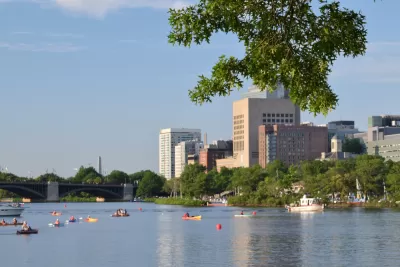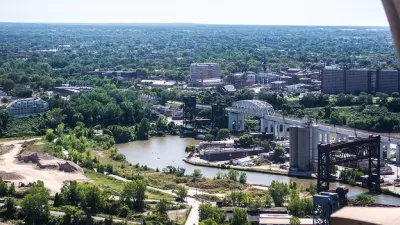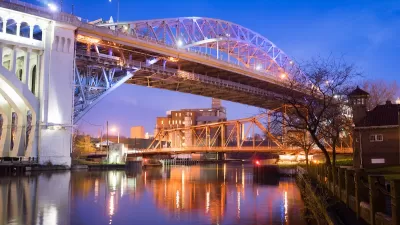On the 50th anniversary of the Cuyahoga River catching fire in Cleveland, it's a good time for urban river keepers everywhere to reevaluate their work and redouble their efforts to make safe and healthy rivers for everyone.

Renée Loth, columnist for the Boston Globe, looks to Cleveland and the Cuyahoga River on the 50th anniversary of that river's most infamous episode (i.e., catching on fire) to not only celebrate the work done to restore that river, but also to look to other rivers around the country for more examples of environmental success.
The Cuyahoga is not the only River Lazarus to come back from the dead. Other US waterways — the Potomac, the Missouri, our own River Charles — have recovered from industrial pollution enough to be fishable and swimmable most of the time. A message runs through it: If mankind stops heaping abuse on the planet, in time it will heal.
The article details the cleanup efforts on the Charles River, which have focused on removing sewer overflows and stormwater runoff that pours hazards off the streets and into the river.
A lot of progress has already been made, especially with regard to sewer overflows. "The EPA’s first water quality report card, in 1995, gave the Charles a D. Thanks to new federal and state mandates, legal pressure from environmental groups, and benefits from the Boston Harbor cleanup, combined sewer overflows have been reduced by well over 90 percent," according to Loth.
Lest Bostonians think their work is done, Loth notes that numerous runoff locations still need to be fixed, and the river has dropped a grade on the water quality report in recent years.
FULL STORY: How to resurrect a river

Study: Maui’s Plan to Convert Vacation Rentals to Long-Term Housing Could Cause Nearly $1 Billion Economic Loss
The plan would reduce visitor accommodation by 25,% resulting in 1,900 jobs lost.

North Texas Transit Leaders Tout Benefits of TOD for Growing Region
At a summit focused on transit-oriented development, policymakers discussed how North Texas’ expanded light rail system can serve as a tool for economic growth.

Why Should We Subsidize Public Transportation?
Many public transit agencies face financial stress due to rising costs, declining fare revenue, and declining subsidies. Transit advocates must provide a strong business case for increasing public transit funding.

How to Make US Trains Faster
Changes to boarding platforms and a switch to electric trains could improve U.S. passenger rail service without the added cost of high-speed rail.

Columbia’s Revitalized ‘Loop’ Is a Hub for Local Entrepreneurs
A focus on small businesses is helping a commercial corridor in Columbia, Missouri thrive.

Invasive Insect Threatens Minnesota’s Ash Forests
The Emerald Ash Borer is a rapidly spreading invasive pest threatening Minnesota’s ash trees, and homeowners are encouraged to plant diverse replacement species, avoid moving ash firewood, and monitor for signs of infestation.
Urban Design for Planners 1: Software Tools
This six-course series explores essential urban design concepts using open source software and equips planners with the tools they need to participate fully in the urban design process.
Planning for Universal Design
Learn the tools for implementing Universal Design in planning regulations.
Ascent Environmental
Borough of Carlisle
Institute for Housing and Urban Development Studies (IHS)
City of Grandview
Harvard GSD Executive Education
Toledo-Lucas County Plan Commissions
Salt Lake City
NYU Wagner Graduate School of Public Service




























